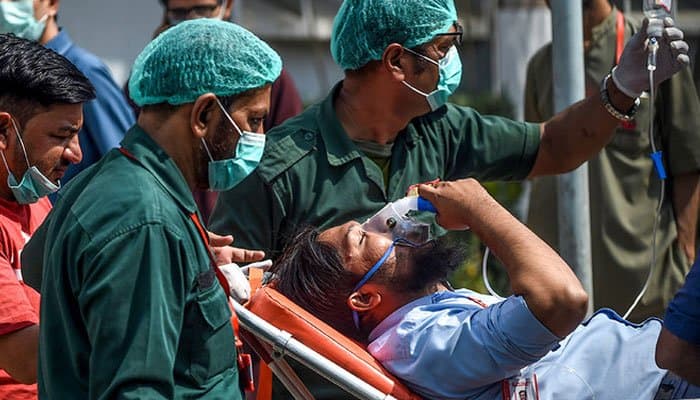COVID-19 cases are surging across the country again. The number of critical care patients have doubled in the past two weeks and “positivity” amongst daily tested is on the rise. Joint Ministerial Meetings between the Education and Health Ministers decided the closure of all educational facilities, moving to home-based and remote learning. Yet, we hear the deaths are “only just 7744” as of 25/11/20 in total. Is this far too much or far too less – given Pakistan’s size, demographic and socioeconomic dynamic – all of which are clear exacerbators of coronavirus transmission?
https://en.dailypakistan.com.pk/digital_images/large/2020-11-30/at-least-2000-additional-deaths-the-real-face-of-covid-19-in-pakistan-1606742968-4262.png
The apparent picture of COVID-19 numbers. Are we bending the curve in Pakistan?
Here’s a breakdown on why the numbers are, in fact, lower than reported.
DATA RELIABILITY
The question about the reliability of data remains in a region with relatively low levels of public health spending. Many deaths are not reported within the vital registration system. The death toll of COVID-19 is not going to be accurate until epidemiologists and statisticians on ground in Pakistan have time to crunch the numbers. But the excess stresses on our healthcare system are clearly evident in countless first-hand reports from emergency rooms and ICUs in our hardest-hit regions.
ATTITUDES AND ACCESS PERTAINING TO COVID-19 TESTING
Testing is synonymous with losing their wages while employees have no option but to isolate while waiting for their tests. A COVID-19 test takes 24-72 hours.
In Pakistan, there is a bigger issue of precarious work. If people cannot attend work, while waiting at home for test results or recovering, they may lose their job altogether.
Through no fault of their own, many people remain uneducated on the severity and transmission of COVID-19 simply because they have zero to minimum interaction with digital platforms, including television where key health and safety measures are announced. The bottom 30% of Pakistan’s income class – the poor and illiterate potentially form an extra 5% of the country’s COVID deaths, often ignoring COVID-19 symptoms as the seasonal flu and proceeding to funeral processes without hospital death inspections.
Furthermore, there is prevalent distrust in the public health system and worry about the extent of government hospital scrutiny a positive result will bring. These concerns cannot be dismissed as paranoid. Fears of invasive procedures are associated with past trauma, such as sexual abuse. Communities who believe to have experienced marginalisation may also be less likely to trust governments and health systems.
FALSE NEGATIVES
Various clinics across the globe have confirmed that more than 30% of RT-PCR results can be falsely negative depending on when the patient’s sample was collected. When patients who have symptoms of COVID-19 but are not tested, test negative or have an inconclusive result die, their deaths are not included.
Leading the COVID-19 response across the Middle East, Senior Pulmonologist, Dr. Rana Najmi clarified, “Pakistan has a major blindspot in the form of suspected deaths because all nucleic acid-based COVID-19 tests (including CBNAAT and RT-PCR) can sometimes return false negatives. Our counterparts at Harvard confirm that the reported rate of false negative results is as high as 50%, which is why antigen tests are not favoured as a single test for active infection. A clinical diagnosis, which a doctor makes based on a person’s symptoms, along with other signs, like a telltale haze on X-rays or CT scans and low blood-oxygen levels, is a more dependable way to identify COVID-19 patients. We could be improving COVID-19 reporting Pakistan through a number of ways, which would lead to more accurate numbers for COVID-19 deaths.”
OVERLAPPING CAUSES OF DEATH
“The locals keep saying older people are dying as they normally would. These are the normal amount of deaths that would be occurring regardless of corona. This is far from the truth, the burden is at least 15% higher. The percentage of elderly and young people dying in the past 6 months are both higher than from the “normal”, prevalent causes of death in Pakistan.” said Dr. Zamir Hidayat (name changed, Jinnah Medical Hospital Karachi).
It is possible that only a fraction of COVID-19 confirmed deaths are being recorded because of the pre-existing conditions the patient may have had, like diabetes, cancer or AIDS which exacerbate COVID-19 symptoms. These so-called “deaths due to comorbidities” are then excluded from the country’s’ death tolls.
For example, lungs are already compromised in those suffering from chronic obstructive pulmonary disease (COPD), asthma or those who are chain-smokers. COVID-19 may be superimposed on the underlying illness. Such an individual may be COVID-19 positive, but the primary cause may be something else, like asthma or COPD. Additionally, COVID-19 is not the cause of death when patients who are immunocompromised with diseases like HIV or tuberculosis.
Dr. Ellie Aziz, based in Lifecare Hospital in Abu Dhabi, further commented “During a pandemic, clinical diagnosis becomes all the more important, although not feasible due to capacity and social distancing reasons. The fact remains between clinical criteria and a lab test, the former is more reliable, unless both tally.”
THE LACK OF BELIEF IN REINFECTION
There is a dire need to understand the virology and characteristics of SARS-COV-2 whether the antibody response is truly protective, and whether reinfection is due to fading immunity or reinfection by a mutant virus. Winter suits many respiratory viruses and may be conducive for corona. What really matters is adapting the control and preventing public health measures. Transmission is on the rise because people are interacting indoors within their confined homes to escape “smart lockdowns.” There are more indoor activities with poor ventilation. Children who were attending school may be carriers to elders.
THE PAST GOING FORWARD
Dr. Muhammad Hakim (MBBS, MS Epidemiology, PhD Scholar at Department of Public Health and Social Sciences, Khyber Medical University) adds that the virus was first confirmed to have reached Pakistan on 26 February 2020, a student in Karachi who had just returned from Iran. For Pakistan it took 8 Months and 12 Days (Total 260 Days) to reach 350,000 confirmed cases of COVID-19 on 12th November 2020,Which is the 27th highest number of confirmed cases in the world.
- From 1st Case to 50,000 Confirmed Cases in 86 Days.
- From 50,000 Cases to 100,000 Confirmed Cases in 17 Days.
- From 100,000 Cases to 150,000 Confirmed Cases in 9 Days.
- From 150,000 Case to 200,000 Confirmed Cases in 11 Days.
- From 200,000 Cases to 250,000 Confirmed Cases in 15 Days
- From 250,000 Cases to 300,000 Confirmed Cases in 60 Days
- From 300,000 Cases to 350,000 Confirmed Cases in 63 Days.
- NEXT to 400,000 Confirmed Cases will be in How many Days???.
The Second Wave in Pakistan has already started.
https://en.dailypakistan.com.pk/digital_images/large/2020-11-30/at-least-2000-additional-deaths-the-real-face-of-covid-19-in-pakistan-1606742711-4159.png
If we rely on the simple ratio of cases/deaths to date (400000:7744 – figures sourced from the Pak Government’s website), based on the rate of increase pictured above, the COVID-19 deaths are expected to increase by at least another 306 deaths in the next 6 months. “When taking into account underreporting and less testing – the two most significant red flags – and based on the trend, we can expect that we have potentially not accounted for up to 6k deaths.” Dr. Hakim.
Summary:
COVID-19 statistics are under-reported in Pakistan, not intentionally. Under-reporting occurs in every disease outbreak worldwide; however, keeping track of the COVID-19 out-break in developing countries is especially challenging. Evaluation of democracy related indicators prove that countries with lower rankings are posed with greater COVID-19 under-reporting issues.
Maintaining an accurate account of the number of national COVID-19 cases is critical for evaluating the national and global burden of the disease and managing COVID-19 prevention and control efforts. Therefore, correlated factors need to be addressed in order to reduce under-reporting. There is heavy reliance on reliable reporting: epidemiologists use it to predict a disease’s trajectory, researchers use it to develop treatments and vaccines, responders utilise it to trace transmission, and the public to protect itself.
The people of Pakistan have declared a premature victory where the real battle is still to come. The symptoms of reinfection are severe in this case and other few reported cases and reinfections have implications for vaccine development and application.
What has become clear is that strong, transparent, and accountable leadership and communication strategies at all levels are crucial in COVID-19 outbreak management to ensure the successful control of epidemic and to prevent secondary problems.













